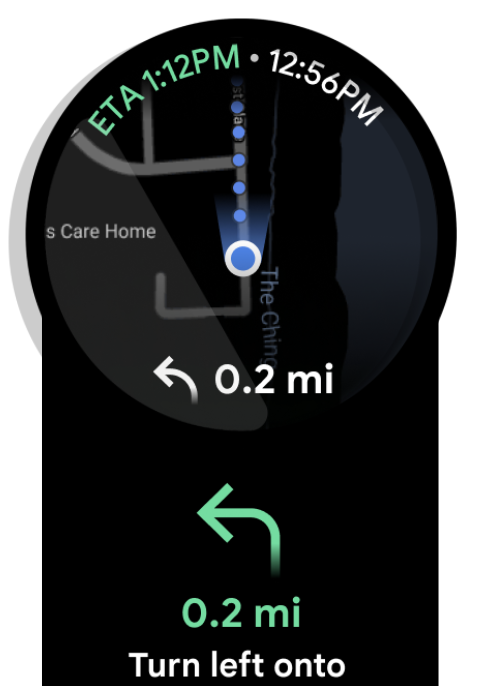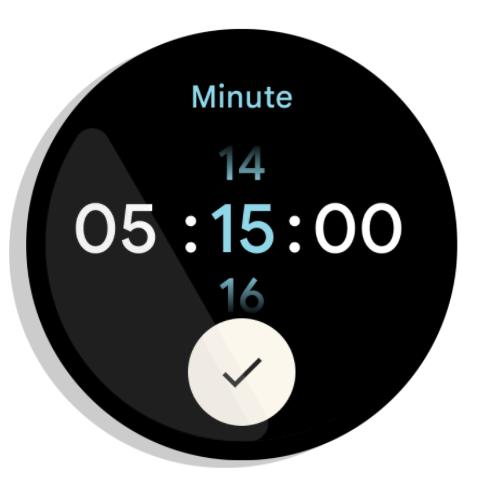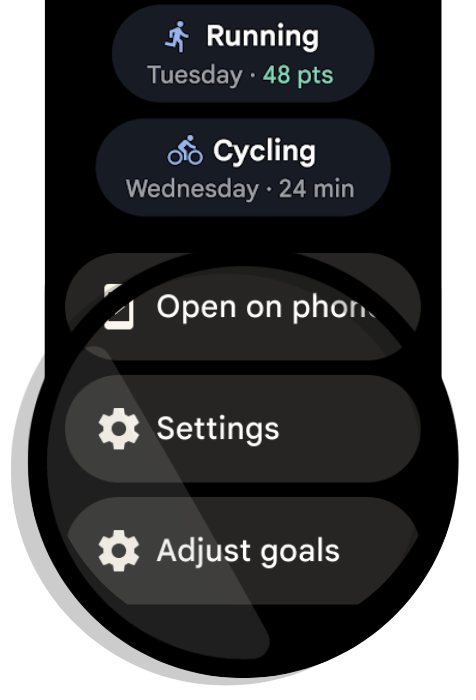Aplikasi adalah tampilan terfokus yang menangani tugas yang terlalu kompleks untuk detail, kartu, atau notifikasi. Aplikasi di Wear OS mirip dengan antarmuka pengguna utama aplikasi seluler. Gunakan platform seperti kartu, detail, dan notifikasi untuk menyelesaikan tugas sederhana, tetapi tautkan platform ini ke dalam aplikasi untuk melakukan tugas yang lebih kompleks.
Tinjau prinsip-prinsip dan kasus penggunaan berikut untuk mendapatkan pemahaman yang lebih baik tentang aplikasi.
Prinsip UX
Buat desain aplikasi dengan mempertimbangkan prinsip-prinsip berikut:
- Fokus
- Fokuskan aplikasi pada tugas penting untuk membantu pengguna menyelesaikan berbagai hal dalam hitungan detik guna menghindari ketidaknyamanan ergonomis atau kelelahan lengan
- Shallow dan linear
- Hindari hierarki yang lebih dalam dari dua tingkat. Tampilkan navigasi inline
- Scroll
- Tampilan dapat di-scroll. Ini adalah gestur alami bagi pengguna untuk melihat lebih banyak konten di smartwatch
Kapan harus menggunakan aplikasi
Gunakan aplikasi dalam situasi berikut:
- Untuk info tambahan
- Fokuskan aplikasi pada tugas penting untuk membantu pengguna menyelesaikan berbagai hal dalam hitungan detik guna menghindari ketidaknyamanan ergonomis atau kelelahan lengan.
- Untuk interaksi yang lebih beragam
- Untuk memberikan interaksi yang lebih beragam daripada detail atau Kartu.
- Untuk menyesuaikan preferensi
- Untuk memberikan akses ke pendidikan dan preferensi.



Membangun aplikasi
Wear OS mendukung dua cara khusus untuk membuat aplikasi:
Compose untuk Wear OS adalah toolkit UI deklaratif modern dan merupakan pendekatan yang direkomendasikan untuk membangun aplikasi di Wear OS.
Pada umumnya, UI berbasis Compose menghasilkan lebih sedikit kode dan mempercepat proses pengembangan aplikasi Android secara keseluruhan. Lihat Mengapa Compose untuk informasi selengkapnya tentang keuntungan umum framework UI deklaratif.
Katalog Material Compose untuk Wear OS mengikuti penataan gaya material, termasuk aksesibilitas bawaan, dan mengimplementasikan penerapan tema material, yang memungkinkan Anda menyesuaikan desain untuk brand Anda. Compose untuk Wear OS menawarkan lebih banyak komponen daripada yang tersedia di View, dan dirancang untuk membantu Anda membuat pengalaman pengguna yang sesuai dengan panduan desain Wear OS.
Jika sudah memiliki aplikasi Wear OS dengan codebase berbasis tampilan yang besar, Anda dapat mengadopsi Compose secara bertahap menggunakan Compose Interoperability API, dan tidak lagi harus menulis ulang seluruh codebase.
Panduan untuk membuat aplikasi dengan Compose
- Menggunakan Jetpack Compose di Wear OS
- Pelajari cara membangun dengan Compose untuk Wear OS.
- Membuat daftar
- Pelajari cara membuat daftar yang dioptimalkan untuk perangkat wearable.
- Menavigasi dengan Compose untuk Wear OS
- Pelajari lebih lanjut cara membuat navigasi di Compose.
- Performa Compose di Wear OS
- Pelajari performa dan pengujian performa aplikasi Anda lebih lanjut.

